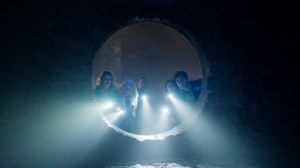If you’re excited for Guillermo del Toro’s Frankenstein, you’ve probably been wondering how he’s going to reinvent the classic. The movie follows Victor Frankenstein and his creature, exploring not just the tragedy of creating life, but also the emotional and moral fallout, in an approach that’s likely to be more sensitive and human. Del Toro is known for blending horror, fantasy, and drama in a way that makes you feel the characters, not just the scares. And with its release set for October in theaters and November on Netflix, how do you survive the wait? Can you get into the film’s vibe with other titles that connect directly to the director’s vision? Absolutely.
Videos by ComicBook.com
Here are 5 movies to watch if you’re hyped for del Toro’s new take on Frankenstein, want to prepare yourself, and also get a clear idea of the visuals, tone, and the monster.
5) The Witch

The Witch is basically a masterclass in building atmosphere and psychological tension. Robert Eggers doesn’t need visible monsters or jump scares, because the movie creates pure horror through isolation, paranoia, and the breakdown of personal bonds. The story follows a 17th-century Puritan family who moves to a farm near a cursed forest. When their newborn goes missing, suspicion and fear bubble up, slowly eating away at the family ties.
The Witch is a perfect watch beforehand because it shows how suffocating tension and introspective characters can make a story far more intense. It’s not clichéd horror, and manages to hook you in a dozen different ways without gimmicks. On top of that, its attention to historical detail and character psychology prepare you for the kind of emotional tension Del Toro is likely to bring to his Frankenstein – because it’s not just about the monster; it’s about the impact of creation and guilt on humanity.
4) The Shape of Water

An Oscar winner and one of del Toro’s most defining works, The Shape of Water tells the story of Elisa (Sally Hawkins), a mute woman working in a secret government lab, and an aquatic creature held in captivity. As they form an emotional connection, a relationship develops. It’s the perfect example of how del Toro makes the audience empathize with a creature that would normally be feared. The movie showcases his signature style while also showing how he humanizes monsters, challenging expectations and biases.
The Shape of Water places heavy emphasis on the creature’s empathy and isolation, and much like the approach planned for Frankenstein, it demonstrates that the real tragedy lies in the humanity of the being itself. Del Toro’s goal is to highlight the inability of those responsible to truly recognize their emotional accountability—much like Victor Frankenstein himself.
3) Pan’s Labyrinth

Another must-watch del Toro film for anyone hyped about Frankenstein is Pan’s Labyrinth. It perfectly encapsulates his visual style and narrative approach. The story follows a young girl named Ofelia (Ivana Baquero) who discovers a magical world during Francoist Spain, while her mother suffers and her stepfather becomes increasingly threatening. It’s a dark fantasy, but one packed with humanity, exploring innocence, cruelty, and resistance.
Based on the material released for Frankenstein so far, Pan’s Labyrinth serves as a reference for the visual style, pacing, and emotional depth we can expect from del Toro’s new movie. One of the standout elements (sometimes unsettling) is the creature design, which raises expectations for Frankenstein as well, because the creatures aren’t just there to impress visually; they reinforce the tone, atmosphere, and emotional weight of the story.
2) Frankenstein (1931)

You can’t really talk about del Toro’s new Frankenstein without watching James Whale’s 1931 original, as it’s the foundation of the cinematic myth. Obviously, the approaches are different: Whale’s version is still firmly rooted in classic horror, while del Toro’s takes a more emotional angle. Still, it’s worth noting how iconic the monster’s design and the gothic atmosphere have become, since the new movie taps into those same roots in its own way.
Basically, watching this original helps you understand del Toro’s choices: he keeps the creature’s central tragedy, but while the 1931 film focuses on shock and visual impact, the new version is expected to highlight the monster’s subjective experience: its feelings, frustrations, and search for connection. Overall, the classic Frankenstein is essential for making comparisons and for understanding the director’s passion for the story, and why it still resonates today.
1) The Bride of Frankenstein

The Bride of Frankenstein is the sequel to the classic, but ironically, it might be the most essential in this case. Why? Beyond being considered by many as superior to the original, it’s a direct reference for del Toro’s Frankenstein. The story follows the creature after the events of the first movie, now grappling with its existence and asking for the creation of a companion. The film fully deepens the monster’s tragedy and introduces the bride to create a dynamic of responsibility and rejection that’s central to the narrative.
Elsa Lanchester as the bride is iconic, and the production blends horror, emotion, and even humor. For audiences excited about the new adaptation, The Bride of Frankenstein is undoubtedly the movie that most directly connects to what we can expect from the new Frankenstein. Del Toro tends to explore the emotional consequences of creation and the complexity of relationships just as masterfully as this film does.
Have you seen any of these movies? Got a favorite? Planning to rewatch them before the new Frankenstein comes out? Let us know in the comments!









